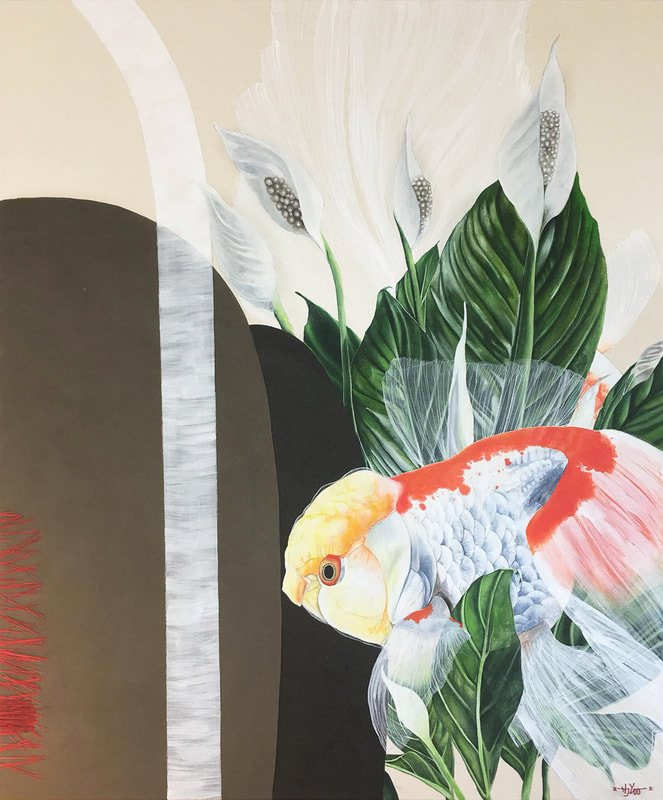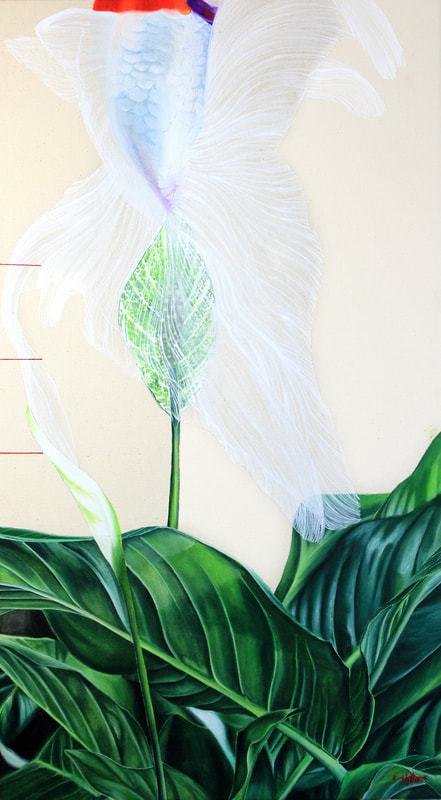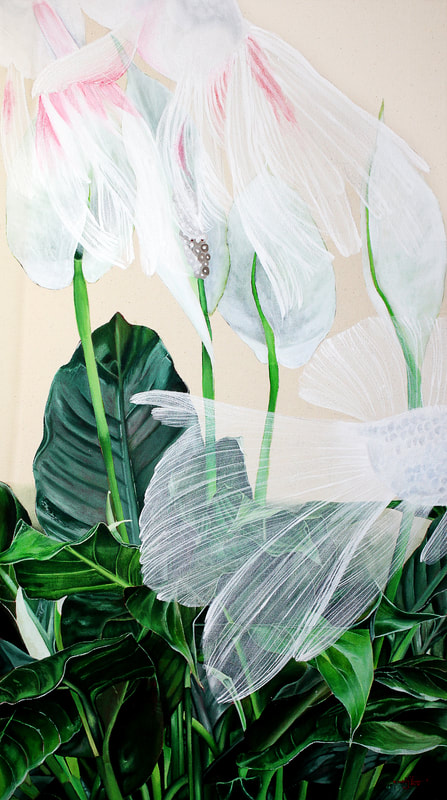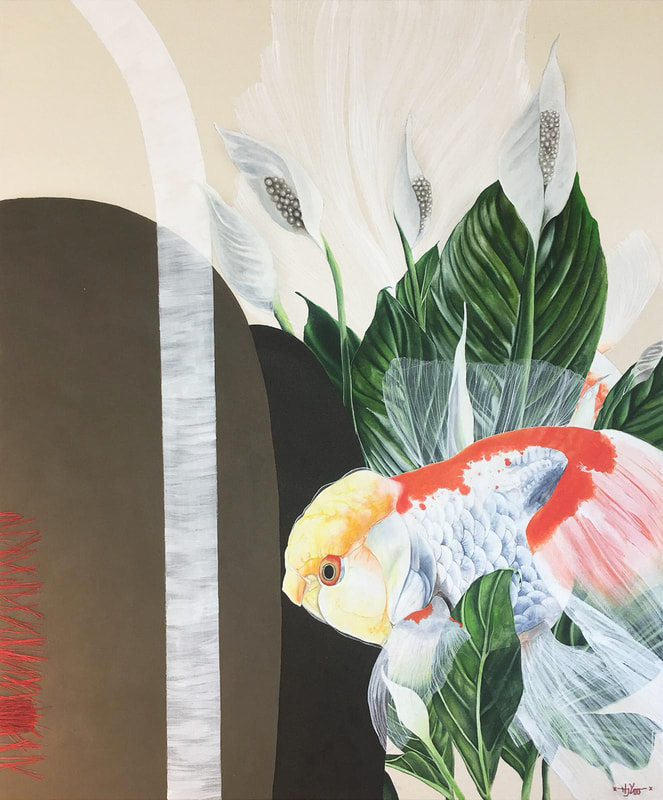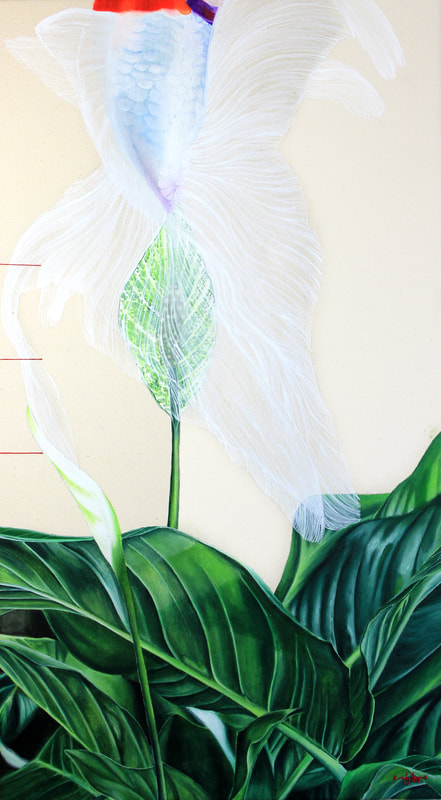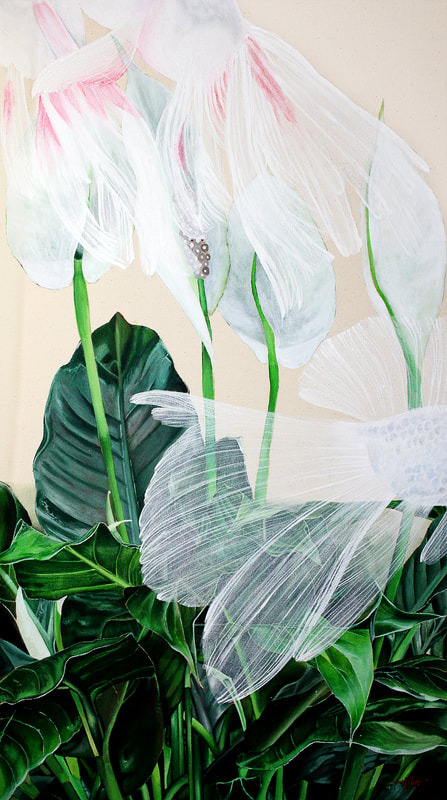- Home
- Portfolio
-
Series
- Woman in the Bath Series (2024) >
- Talisman Series (2023) >
- Birth Dream (2023)
- i live in a burning house (2021) [SOLD]
- New Life (2023) [SOLD]
- Spirit Illness series (2020-21) >
- Portrait Series (2020) >
- Peace Lily Playground (2019)
- Friendship Ending
- the S(PA)RROW series (2019)
- Mountain Landscape Series (2017)
- Exhibitions
- Shop
- About / Contact
- SUBSCRIBE ✉️
encounter‘Encounter’ is the first painting in the ‘Peace Lily Playground’ series and is about a memorable event that happened when I was a child growing up in South Korea.
The moment brought shock, due to the sense of irony, which I had never felt before. I was a healthy child, who lived at home and went to school, yet somehow my perspective on the world was so much darker and pessimistic than a boy who lived in a nearby hospital. In the painting, the boy is represented by the Goldfish, who lived in this foreign environment that I had never seen before. He broadened my whole perspective on the world, in the sense that it was much bigger than home, which had consistently brought disorder in my life. This disorder is illustrated by the chaotic nature of the red stitching that bends around the border of the painting, as if gripping to my being. The sudden subconscious realisation I had from this boy carried a sense of calmness to my being, and delivered peace and hope—as shown by the peaceful and dreamlike floating of the Goldfish through a playground of Peace Lilies. |
overexposed‘Overexposed’ is the second painting in the ‘Peace Lily Playground’ series and is about the moment I had experienced after meeting a young boy (the Goldfish) at a hospital’s playground. After visiting the playground a few too many times, there were some mixed sensations, such as a sense of dullness due to being overexposed to a new thing. This is represented by the greened Peace Lily flower, which is me. The white flowers from the Peace Lily turns green when overly exposed to the sun. I had a sense of denial and I didn’t want to let go of the initial feeling of amazement—as if a shiny curtain draped over my eyes.
I had brought my 5-year-old sister to the playground, in a wish that she’d take away the amazing experience I had initially felt. Subconsciously, I was trying to integrate my unhappy home-life with the good sensation I had with the children at the hospital. But, I quickly awoke from this intention when my little sister became very scared of the new environment. Suddenly, I felt the need and instinct to protect my sister (represented by the sprouting Peace Lily), which overrode everything I had initially felt. Although naturally protective of my sister, this reaction was also a reflection of the symptoms having developed PTSD, in which I would always position myself as less important than others. This painting is about lot of mixed feelings but this is also about family. The three red strings here represent people who are bound together as family and in fate. Subsequently, there are three figures in this painting: myself, my little sister, and a ghost-like flower who represents another sister that was miscarried. This little ghost-like flower is situated in the lower middle of the canvas under a rib-like leaf where a womb would have been located if you saw the painting as a body. |
subconscious
’Subconscious’ is the third painting from the ‘Peace Lily Playground’ series and is a story of a girl with PTSD. As a sufferer of PTSD for 17-years, flash backs are uncontrollable and mixed complicated emotions can be intense, but over the decade I’ve learned to hide them very well. Trying to survive with it means always fighting with inner darkness. The darkest part of the painting, with the sharpest leaves, are covered by a sheer fish tail. It’s covered, but not completely. If you look closely you can see the darkness underneath. Then, rotated flowers represent the people that turned their backs on me. I attempt to block out the pain of my past, as if I’m wearing rose-coloured glasses, but, the truth can easily appear, as the gold fish tails are in movement and could show their faces at any moment. The goldfish are not in perfect proportion and lack elements of detail. This is to accentuate what my subconscious was seeing in my mind. Meanwhile, two red stitched crosses represent eyes of abuse.
|
|
Use the 'SUMMER' discount code at checkout to get 15% OFF and Free Shipping on your order.
Instructions on how to care for your art > |
© COPYRIGHT 2024. ALL RIGHTS RESERVED. Web design by Greg Beazley
|

